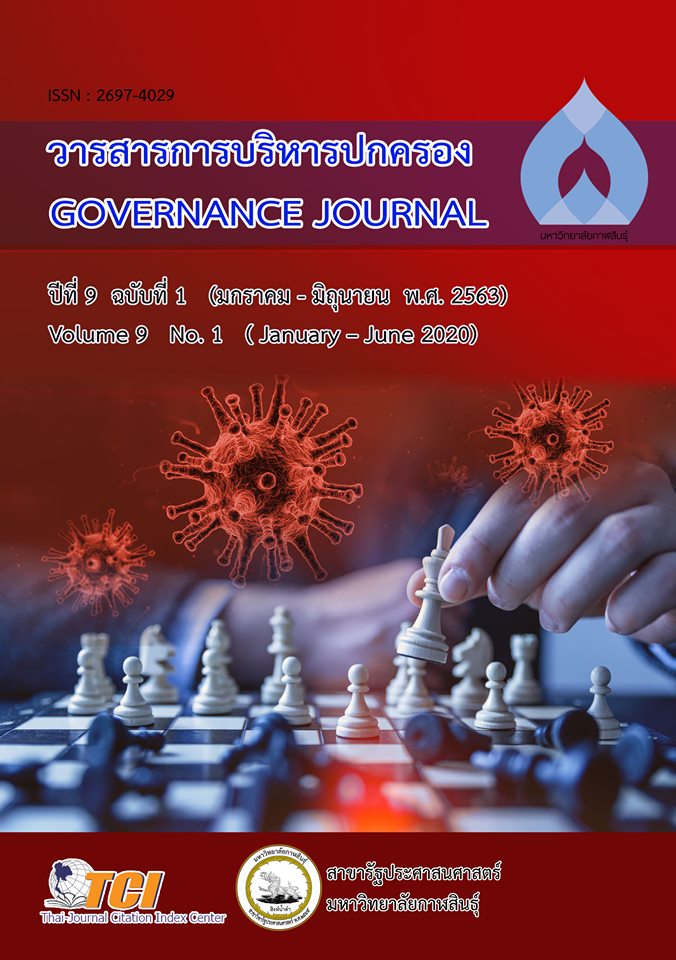ตัวแปรพยากรณ์ของการพัฒนารัฐบาลอิเล็กทรอนิกส์: กรอบการวิจัยที่ถูกกำกับ
DOI:
https://doi.org/10.14456/gjl.2020.4คำสำคัญ:
รัฐบาลอิเล็กทรอนิกส์, เทคโนโลยีสารสนเทศและการสื่อสาร, ความเชื่อมั่นบทคัดย่อ
เทคโนโลยีสารสนเทศกำลังแทรกซ้อนเข้ามาในชีวิตมนุษย์อย่างรวดเร็ว ซึ่งกระตุ้นให้เกิดความจำเป็นที่ต้องเปลี่ยนแปลงรูปแบบของการให้บริการ รัฐบาลต่างๆ กำลังมุ่งสู่การจัดตั้งรัฐบาลอิเล็กทรอนิกส์ อย่างไรก็ตาม การละเมิดระบบรักษาความปลอดภัยเมื่อไม่นานมานี้ได้สร้างความกังวลต่อความปลอดภัยในข้อมูลและความเป็นส่วนตัว ดังนั้น การวิจัยนี้จึงมุ่งเน้นตรวจสอบปัจจัยต่างๆ ที่มีผลต่อการพัฒนารัฐบาลอิเล็กทรอนิกส์ นอกจากนั้น ความเชื่อมั่นในรัฐบาลถูกพิจารณาให้เป็นตัวแปรกำกับ ซึ่งข้อมูลที่ใช้ในการวิจัยนี้ถูกรวบรวมจากกลุ่มพนักงานธนาคารในประเทศไทย โดยโมเดลสมการโครงสร้างแบบวิธีกำลังสองน้อยที่สุดบางส่วน ถูกใช้ทดสอบสมมติฐานความสัมพันธ์ระหว่างตัวแปรต่างๆ ทั้งนี้ ผลการศึกษาพบว่ามีความสัมพันธ์เชิงบวกอย่างมีนัยยะสำคัญระหว่างปัจจัยทั้งหมดคือ ปัจจัยทางเศรษฐกิจ สังคม และการเมือง และการพัฒนารัฐบาลอิเล็กทรอนิกส์ ยิ่งไปกว่านั้น โครงสร้างพื้นฐานทางเทคโนโลยีสารสนเทศและการสื่อสารถูกพบว่ามีส่วนเกี่ยวข้องกับการพัฒนารัฐบาลอิเล็กทรอนิกส์ด้วยเช่นกัน คณะผู้วิจัยเชื่อแน่ว่าสิ่งที่ค้นพบจากการศึกษานี้จะเป็นประโยชน์ต่อผู้กำหนดนโยบายและจะเป็นแนวทางต่อบริบทภาพรวม พร้อมกันนี้ ได้เสนอแนวทางในอนาคตของการศึกษาเพิ่มเติมเรื่องนี้ไว้ให้ด้วย
Downloads
เอกสารอ้างอิง
Akkaya, C., Obermeier, M., Wolf, P., & Krcmar, H. (2011). Components of
trust influencing egovernment adoption in Germany. (Paper presented at the International Conference on Electronic Government).
Al-Zoubi, M., Thi, L., & Lim, H. (2011). E-Government adoption among
businesses in Jordan. Academic Research International, 1(1), 141-156.
Alam, K., Erdiaw-Kwasie, M., Shahiduzzaman, M., & Ryan, B. (2018).
Assessing regional digital competence: digital futures and strategic planning implications. Journal of rural studies, 60, 60-69.
Almarabeh, T., & AbuAli, A. (2010). A general framework for e-Government:
definition maturity challenges, opportunities, and success. European Journal of Scientific Research, 39(1), 29-42.
Andersen, K., Medaglia, R., Vatrapu, R., Henriksen, H., & Gauld, R. (2011).
The forgotten promise of e-Government maturity: Assessing responsiveness in the digital public sector. Government Information Quarterly, 28(4), 439-445.
Bélanger, F., & Carter, L. (2008). Trust and risk in e-Government adoption.
The Journal of Strategic Information Systems, 17(2), 165-176.
Carrillo, F., Metaxiotis, K., Yigitcanlar, T., Mohamed, M., Murray, A., &
Mohamed, M. (2010). The role of information and communication technology (ICT) in mobilization of sustainable development knowledge: a quantitative evaluation. Journal of knowledge management, 14(5), 744-758.
Carter, L., & Bélanger, F. (2005). The utilization of e‐government services:
citizen trust, innovation and acceptance factors. Information systems journal, 15(1), 5-25.
Chang, C.-T., Hajiyev, J., & Su, C.-R. (2017). Examining the students’
behavioral intention to use e-learning in Azerbaijan? The general extended technology acceptance model for e-learning approach. Computers & Education, 111, 128-143.
de Oliveira Carneiro, D., dos Reis, M., Cireno, M., Lima, B., dos Santos, A.,
de Lima Ayres, J., & Junior, D. (2019). Parliamentary Amendment Mobile Application: A Qualitative Approach About E-Government. (Paper presented at the World Conference on Qualitative Research).
E-Government Development Index. (2014). E-Government Development
Index by country: 2008-2014. Retrieved from digital.gov.ru/en/activity/statistic/rating/index-razvitiya-elektronnogo-pravitelstva/#tabs|Compare:
Place.
Economist Intelligence Unit. (2010). Digital economy rankings 2010.
Retrieved from www935.ibm.com/services/
us/gbs/bus/html/ibv-digitaleconomy2010.html
Hair, B., & Babin, A. (2006). Multivariate data analysis. 6th ed. New Jersey:
Pearson Prentice Hall.
Hair, J., Black, W., Babin, B., & Anderson, R. (2009). Multivariate data
analysis. Vol. 6. 7th ed. New Jersey: Pearson Prentice Hall.
Heeks, R., & Bailur, S. (2007). Analyzing e-Government research:
Perspectives, philosophies, theories, methods, and practice. Government Information Quarterly, 24(2), 243-265.
Henseler, J., Ringle, C., & Sarstedt, M. (2015). A new criterion for assessing
discriminant validity in variance-based structural equation modeling. Journal of the academy of marketing science, 43(1), 115-135.
Janita, M., & Miranda, F. (2018). Quality in e-Government services: A
proposal of dimensions from the perspective of public sector employees. Telematics and Informatics, 35(2), 457-469.
Khasawneh, R., Rabayah, W., & Abu-Shanab, E. (2013). E-Government
acceptance factors: trust and risk. (Paper presented at the the 6th international conference on information technology).
Knickrehm, M., Berthon, B., & Daugherty, P. (2016). Digital disruption: The
growth multiplier. Accenture Strategy. Retrieved from www.accenture.com/us-en/insight-digital-disruption-growth-multiplier
Kumar, V., Mukerji, B., Butt, I., & Persaud, A. (2007). Factors for successful
e-Government adoption: A conceptual framework. Electronic Journal of E-Government, 5(1), 63-76.
Kurfalı, M., Arifoğlu, A., Tokdemir, G., & Paçin, Y. (2017). Adoption of e-
Government services in Turkey. Computers in Human Behavior, 66, 168-178.
Liu, D., & Carter, L. (2018). Impact of citizens' privacy concerns on e-
Government adoption. (Paper presented at the Proceedings of the 19th Annual International Conference on Digital Government Research: Governance in the Data Age).
Mensah, I., & Mi, J. (2019). Predictors of the Readiness to Use E-Government
Services From Citizens' Perspective. International Journal of Technology Diffusion, 10(1), 39-59.
Nyakwende, E., & Al Mazari, A. (2012). Factors affecting the development
of e-Government in Saudi Arabia. (Paper presented at the International Conference on Electronic Government and the Information Systems Perspective).
Patel, H., & Jacobson, D. (2008). Factors Influencing Citizen Adoption of
E-Government: A Review and Critical Assessment. (Paper presented at the ECIS).
Shareef, M., Kumar, V., Kumar, U., & Dwivedi, Y. (2011). e-Government
Adoption Model (GAM): Differing service maturity levels. Government Information Quarterly, 28(1), 17-35.
Sorn-In, K., Tuamsuk, K., & Chaopanon, W. (2015). Factors affecting the
development of e-Government using a citizen-centric approach. Journal of Science & Technology Policy Management, 6(3), 206-222.
Twizeyimana, J., & Andersson, A. (2019). The public value of E-
Government–A literature review. Government Information Quarterly, 36, 167-178.
United Nations. (2014). United Nations E-Government Survey 2014: E-
Government for the future we want. New York: United Nations Department of economic and social affairs.
Weerakkody, V., El-Haddadeh, R., & Al-Shafi, S. (2011). Exploring the
complexities of e-Government implementation and diffusion in a developing country: Some lessons from the State of Qatar. Journal of Enterprise Information Management, 24(2), 172-196.
World Bank. (2012). Information and communications for development
2012: Maximizing mobile: Washington, D.C.: World Bank.
World Bank. (2016). Digital Dividends: World Development Report 2016.
Washington, DC.: The World Bank.
Yildiz, M. (2007). E-Government research: Reviewing the literature,
limitations, and ways forward. Government Information Quarterly, 24(3), 646-665.
ดาวน์โหลด
เผยแพร่แล้ว
รูปแบบการอ้างอิง
ฉบับ
ประเภทบทความ
สัญญาอนุญาต

อนุญาตภายใต้เงื่อนไข Creative Commons Attribution-NonCommercial-NoDerivatives 4.0 International License.








